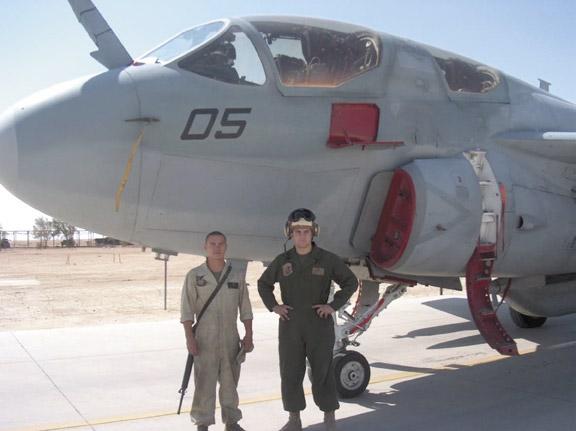
10 minute read
Crash During a Mundane Task
By AM3 Kawin Gilliam
Iwas finishing my second detachment to Bahrain as plenty of sleep that night and even dreamed about being part of HSC-2, Det 2, the “World Famous Desert back in the States. The workload started off normally Ducks,” who, at the time, still were flying the triedenough, with an ATAF (all tools accounted for), workand-true UH-3H Sea King. It was three days before I load reports, maintenance meeting, etc. The detachwas scheduled to leave, and I would be lying if I said I ment was planning a two-bird launch up to the North wasn’t thinking about going home. The day, however, Arabian Gulf to drop off passengers, mail and cargo to would end with my wishing I had concentrated on work! U.S. and coalition ships operating in support of Opera
Advertisement
The morning started off like countless others: a tion Iraqi Freedom. 0645 muster at the NSA Bahrain gate for the ride out to As normal, we went out to the line to prep the the Bahrain International Airport where we operate. I had birds, get them ready to fly, and check servicing before
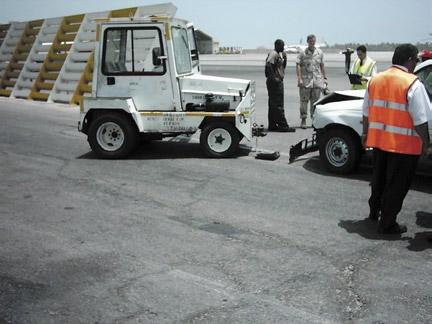
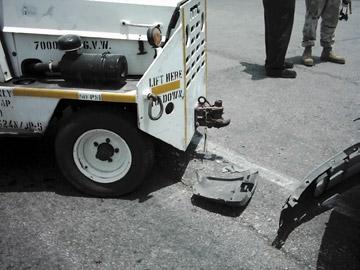

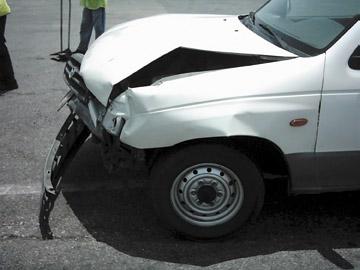


the pilots walked for their preflight. After the aircraft were ready, we moved one bird from our assigned parking spot to the JBD (jet blast deflector) spot. It was around 0850 when the pilots arrived to preflight and get ready for the launch.
As the pilots arrived, the cargo and mail personnel arrived, too, with the boxes of cookies, bags of mail, and CASREP parts for the ships. As usual, the maintainers helped the aircrew load the aircraft to expedite the launch. Standard operating procedure on the flight line, in the blistering heat of Bahrain, is to ensure that our CamelBaks are full of water at all times. With the balmy 42-degree-Centigrade temperature and the heat index hovering around 125 degrees Fahrenheit, our CamelBaks quickly were going empty.
When the first bird was loaded, we were running low on water. The pilots finished their preflight, strapped in, and launched without a problem. After the first launch, half the maintainers walked into the shop to refill their CamelBaks with some cool, refreshing H 2 O. I stayed out to help load the second bird. When most of the maintainers made it back to finish up, I took it upon myself to jump on a tow tractor and drive back to the shop to refill my CamelBak. Once I was topped off with water, I drove the tow tractor back to the line to help with the launch.
To get where the bird was parked, I had to drive around the perimeter of the flight line on a paved access road. This trip can take a couple of minutes, so I hurried. I could tell the bird really was close to pushing out because I could see the No. 1 engine was online, and
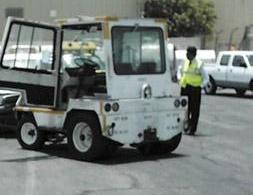
people were standing around waiting to disconnect and move the NC-10.
Everyone was waiting on the tow tractor and me. I got around the back of the JBD and was looking to get to the bird as fast as I could, but I had to make one final, no fuss, no muss, left turn to cross the access road and drive out onto the line. I was focused on the bird and the need to move the NC-10. As a result, I failed to look straight ahead to see if anybody was coming down the opposite side of the road. As I turned left, a little Toyota pickup appeared right in my face. We hit almost headon. I wasn’t hurt, and the tow tractor wasn’t damaged, except for a couple of small scratches on the nose.
The local Bahrain Airport Services employee in the Toyota wasn’t hurt either, but the truck didn’t fare so well. The damage was significant, and it couldn’t be moved without help of a tow truck. Needless to say, the launch went late, and I was speechless. The detachment had to borrow a tow tractor, and I began what turned out to be a very long day.
After explaining everything to my chief, the maintenance officer, the police, and my OinC, I had the opportunity to explain what had happened one more time to the airport manager himself. In short, my focus and concentration on launching the bird, mixed with some end-of-deployment get-home-itis, caused me to lose situational awareness. This otherwise simple maneuver totally went awry. While no one was hurt, it easily could have ended differently. Trucks and pride can be fixed; I’m simply glad a person didn’t need to be repaired.
Petty Officer Gilliam works in the airframes shop at HSC-2.
Send BZs to: SAFE-Mech@navy.mil






AD1(AW) Mark Hudson HSL-44 Det 8
Petty Officer Hudson discovered fuel leaking from the No. 1 engine of Magnum 440 during a hot-section wash. Further inspection revealed a missing O-ring packing in an area that leads from the overspeed and drain valve into the accessory gearbox, causing fuel to leak during normal operation. Petty Officer Hudson’s keen attention to detail allowed him to initiate timely repairs and break the mishap chain, making MAGNUM 440 immediately available for the tasking from the Carrier Strike Group deployed in the Arabian Gulf.



PO2 Reagan Payne USCG Air Station, Clearwater, Fla.
While in support of recovery operations for Hurricanes Katrina and Rita, Petty Officer Payne was completing an hourly engine inspection on a Sikorsky HH-60J search and rescue helicopter. Using a state-of-the-art borescope, Petty Officer Payne found several hairline cracks in the No. 1 engine high-speed shaft flex pack.
Petty Officer Payne’s strict attention to detail most certainly prevented a major catastrophic failure of the No. 1 engine high-speed shaft, avoiding possible damage to the airframe and, most importantly, averting a potential mishap.

AD3 Richard Bailey and AM2 Brian Rimler VAW-124
Petty Officer Bailey was positioned next to the main entrance hatch of an E-2C Hawkeye as a safety observer. His shipmate was doing an internal aircraft final inspection before launch. When exiting the hatch, the shipmate turned the wrong direction and headed toward the aircraft’s rotating propeller. Petty Officer Bailey immediately grabbed the individual, preventing a catastrophic loss of life.
Petty Officer Rimler acted with commendable courage while stationed near the catapult shot line as a final checker. He recognized a member of the ship’s catapult crew unknowingly break the propeller safety chain, which was composed of squadron personnel.
AM3(AW) Jeremy Pavlosky VAQ-139
Acting as the port-exhaust safety observer during a night launch, Petty Officer Pavlovsky observed a ship’s V1 director climb out of the catwalk and up the ladder in direct line of the turning EA-6B exhaust. Ignoring Petty Officer Pavlovsky’s waving flashlight, the director proceeded to climb the ladder. As the director reached the flight deck, the EA-6B exhaust nearly knocked him from the ladder and over the side of the catwalk.
Petty Officer Pavlovsky reacted quickly, pulling the director by his float coat onto the flight deck and out of the line of the exhaust.




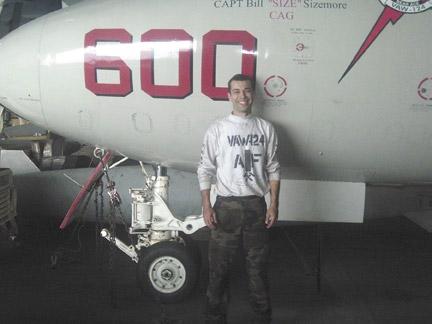
AM3 Bradley Lawson VAW-124
During a day launch of Hawkeye 600 while on deployment on board USS Theodore Roosevelt, a young plane captain from another squadron was following his aircraft up the “street.” The individual ducked underneath the rear of the FA-18, stepping through the prop-arc safety chain and heading straight for the prop. Petty Officer Lawson immediately grabbed him and knocked the individual out of the way mere inches from being hit by a propeller.
Petty Officer Lawson’s quick actions and safety mindset prevented a tragic mishap.
AM2 (NAC) Brian Gillespie and AM3 Kathryn Cayer VR-62
During engine start-up for a routine training mission, the second loadmaster, Petty Officer Gillespie, and plane captain, Petty Officer Cayer, were positioned in front of the aircraft to observe the start. They noticed the inboard, life-raft-compartment door on top of the starboard wing momentarily spring open and then return to a normal position. They immediately notified the aircraft commander, who terminated the start.
Upon further investigation, squadron personnel found that the life-raft-compartment latches had released, allowing the propeller wash to blow open the door.
Petty Officers Gillespie and Cayer caught a fleeting glimpse of a problem that could have resulted in an in-flight deployment of the life raft, which could have jammed the flight controls and caused serious damage to aircraft and the possible loss of the aircrew.
AT2(AW) Shannon Strickland VX-20
A P-3 was sent on a logistics mission to deliver mission-capable parts for a detached squadron aircraft. Upon arrival and after securing the engines, the ground crew began to download the parts and associated gear.
Petty Officer Strickland noticed hot brakes on the port side of the aircraft, immediately stopped the download evolution, and then cleared everyone away from the explosive hazard that existed.

Sgt. Michael Blua and LCpl. Joshua Gomez VMAQ-1
While supporting 24-hour combat flight operations, Sgt. Blua and LCpl. Gomez were investigating engine irregularities on one of the squadron’s EA-6B Prowlers. LCpl. Gomez was first to discover a small crack in the port inlet casing, which was visible only from inside the inlet. He suspected the crack would be larger underneath the surface. After NDI, the crack was found to be more than six inches long. Had the aircraft been flown, it is likely that catastrophic engine failure would have occurred from FOD.
Sgt. Blua was convinced the port engine still wasn’t running properly, so he insisted on having the engine borescoped. His attention to detail paid off when the results showed a firststage turbine stator had been burned away to less that half its normal size. Continued operation of this engine would have resulted in failure of the stator and possible FOD damage.
AN James McClure VFA-14
On a routine day during WestPac 2005 on board USS Nimitz, everything was going according to plan. Camelot 200 had just recovered and was taxied to a spot in the corral. Airman McClure was the plane captain and had just returned from 90 days TAD on the mess decks. The aircraft director turned over the aircraft for shutdown. After securing the port engine and while waiting for the pilot’s signal to shut down the starboard engine, purple shirts arrived to fuel the aircraft for the next launch.
One of the purple shirts attempted to untangle a grounding strap and unknowingly walked directly toward the starboard intake. He was dangerously close to the intake when Airman McClure grabbed his float coat and pulled him to safety.


